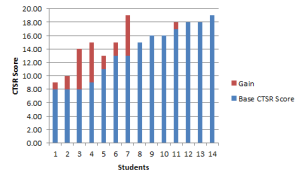Last year I posted about a quick study I did involving the Classroom Test of Scientific Reasoning. In the post, I showed that students made gains in their scores on the test when they were shown physical demonstration of the apparatus. For example, I put two balls of putty on balances and showed them equal, then squished one. The results suggested that many of the students were getting caught up on the language of the test.
This year, I repeated the experiment with my new class of grade 11 physics students. However, there was only one changed answer in this second attempt. I suggest this means that the current group of students understood the test questions much better. This parallels my experience, as most of the students in the class have been at our school for a few years, whereas last year many had just arrived after moving from abroad.

Test results from 2014 and 2015. A lower line is better. In 2015 70% of my students scored 6 or less (similar to the US national average for high school students), compared with 50% in 2014, and only 30% in 2014 after the demonstration.
I haven’t yet gone through the answers to look at the students’ reasoning skills, but the results look similar to the pre-demonstration scores from last year, which I think means the students have a lower overall comfort level with scientific reasoning. My challenge is to find ways to embed these skills in our studies this year.



